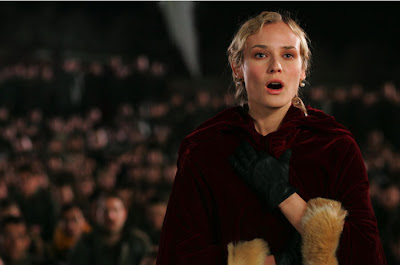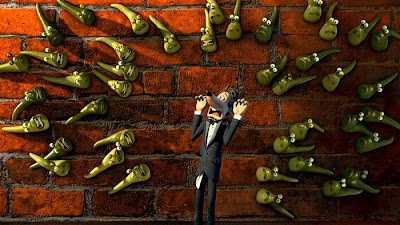
Ian Carter: Chiwetel Ejiofor
Susie Carter: Sophie Okonedo
Nick Fraser: Tim Roth
Kathy Graham: Toni Collette
Tony Whittaker: Hugh Bonneville
Kim Peabody: Gina McKee
Than: Samrit Machielsen
Ellen: Kate Ashfield
HBO Films and BBC present a film directed by Bharat Nalluri. Written by Abi Morgan. Running time: 185 min. Rated TV-MA (for adult content, violence, and language).
On December 26, 2004, much of the world awoke to the first reports of one of the largest natural disasters ever seen. I know I had trouble conceiving the magnitude of the tsunami, which affected 13 countries and killed over 200,000 people. It was like a made-for-TV disaster flick, but much worse than any Hollywood producer could have ever conceived.
Now, HBO has made a television mini-series out of that terrible event. Luckily, they have taken a cue from the ‘80’s television nuclear drama “The Day After”, and focused on the events following the disaster rather than concentrating on the tsunami itself. Instead of making some mid-disaster melodrama like “Hurricane” or “The Towering Inferno”, director Bharat Nalluri and writer Abi Morgan look at the struggles and heartbreaks of the survivors in this fictional account of what happened in the days following the tsunami.
The film follows several different character storylines to give the audience a broad overview of all the different efforts that were made during the relief effort. The stories themselves are rather academic. Nalluri and Morgan tell them in much the same way the film’s website lays out facts about the tsunami. Although they have fictionalized the events, it all has the feel of some sort of classroom lesson. It is very interesting to learn about all the things that happened that the general public might be unaware of, but the film lacks some dramatic flare.
That is not to say that it is emotionally ineffective. The catastrophic nature of the tsunami by itself leaves an emotional impact. It tears lives apart, even for those who came after and did not experience the wave itself. It is almost strange that I could be so emotionally affected by a film that is not great, but merely good.
It is the actors who carry all the emotional power of the stories. The strong performances are lead by Chiwetel Ejiofor (“Inside Man”) as Ian, a father who loses his grip on his 6 year-old daughter’s hand during the wave impact. He last sees her hanging onto a tree. The mother, Susie, is out deep sea diving and returns to the devastated coast line with no idea what has happened to her husband or daughter.
The two eventually find each other; the father feels shame for allowing the daughter to get away, the mother resents him. Sophie Okonedo (“Hotel Rwanda”) handles the difficult chore of presenting a mother who is willing to replace her daughter with another displaced little girl rather than accept her own offspring’s possible death. A powerful breakdown occurs between the couple when Ian voices his regrets and lashes out at Susie for not being there at all.
Gina McKee (“Notting Hill”) turns in a traumatized performance as Kim Peabody, a mother on the same deep sea diving excursion with one son, who must search out another son and her husband. She finds the boy in a Thai hospital and tries to get help from the British Embassy to have him evacuated to a British hospital for better care before Thai doctors amputate his leg. All the while, her youngest son insists on a heartbreaking search for their father.
Hugh Bonneville (“Iris”) gives a strong performance as the British government representative on site to establish aide for British victims. He struggles with doing what he is told by the government and with what is necessary for the survivors he has to look in the eye. Meanwhile, Tim Roth (“Dark Water”) turns in a typically solid performance as a journalist with a conscience. And once again, Toni Collette (“In Her Shoes”), as a school teacher who leads the British relief effort, shows that she can turn anything she’s involved with into gold. Let’s just pretend “Connie and Carla” never happened.
There are some conspiratorial overtones to a storyline involving a hotel chain that reclaims some coastal land where locals have lived for generations. But this is the most confused area of the film. The filmmakers make a point about how the Thais are unfairly treated in terms of ownership, but they seem distracted more by the dangers of reconstruction in an area where the underwater fault line threatens to one day re-create the same catastrophe. In this sense, the corporate takeover of land is actually saving the Thai locals from future destruction, and provides a thriving job market and economy.
It is nice to see that the typical disaster flick can be transformed into a thinking man’s drama. The performances make the film worth watching and go a long way toward carrying across the filmmakers’ points. But it would be good to get a better balance between the “facts” and the awesome nature of the situation. It is a strong representation of the aftermath indeed, but doesn’t quite transport the viewer to the tragedy we desperately need to understand.
Susie Carter: Sophie Okonedo
Nick Fraser: Tim Roth
Kathy Graham: Toni Collette
Tony Whittaker: Hugh Bonneville
Kim Peabody: Gina McKee
Than: Samrit Machielsen
Ellen: Kate Ashfield
HBO Films and BBC present a film directed by Bharat Nalluri. Written by Abi Morgan. Running time: 185 min. Rated TV-MA (for adult content, violence, and language).
On December 26, 2004, much of the world awoke to the first reports of one of the largest natural disasters ever seen. I know I had trouble conceiving the magnitude of the tsunami, which affected 13 countries and killed over 200,000 people. It was like a made-for-TV disaster flick, but much worse than any Hollywood producer could have ever conceived.
Now, HBO has made a television mini-series out of that terrible event. Luckily, they have taken a cue from the ‘80’s television nuclear drama “The Day After”, and focused on the events following the disaster rather than concentrating on the tsunami itself. Instead of making some mid-disaster melodrama like “Hurricane” or “The Towering Inferno”, director Bharat Nalluri and writer Abi Morgan look at the struggles and heartbreaks of the survivors in this fictional account of what happened in the days following the tsunami.
The film follows several different character storylines to give the audience a broad overview of all the different efforts that were made during the relief effort. The stories themselves are rather academic. Nalluri and Morgan tell them in much the same way the film’s website lays out facts about the tsunami. Although they have fictionalized the events, it all has the feel of some sort of classroom lesson. It is very interesting to learn about all the things that happened that the general public might be unaware of, but the film lacks some dramatic flare.
That is not to say that it is emotionally ineffective. The catastrophic nature of the tsunami by itself leaves an emotional impact. It tears lives apart, even for those who came after and did not experience the wave itself. It is almost strange that I could be so emotionally affected by a film that is not great, but merely good.
It is the actors who carry all the emotional power of the stories. The strong performances are lead by Chiwetel Ejiofor (“Inside Man”) as Ian, a father who loses his grip on his 6 year-old daughter’s hand during the wave impact. He last sees her hanging onto a tree. The mother, Susie, is out deep sea diving and returns to the devastated coast line with no idea what has happened to her husband or daughter.
The two eventually find each other; the father feels shame for allowing the daughter to get away, the mother resents him. Sophie Okonedo (“Hotel Rwanda”) handles the difficult chore of presenting a mother who is willing to replace her daughter with another displaced little girl rather than accept her own offspring’s possible death. A powerful breakdown occurs between the couple when Ian voices his regrets and lashes out at Susie for not being there at all.
Gina McKee (“Notting Hill”) turns in a traumatized performance as Kim Peabody, a mother on the same deep sea diving excursion with one son, who must search out another son and her husband. She finds the boy in a Thai hospital and tries to get help from the British Embassy to have him evacuated to a British hospital for better care before Thai doctors amputate his leg. All the while, her youngest son insists on a heartbreaking search for their father.
Hugh Bonneville (“Iris”) gives a strong performance as the British government representative on site to establish aide for British victims. He struggles with doing what he is told by the government and with what is necessary for the survivors he has to look in the eye. Meanwhile, Tim Roth (“Dark Water”) turns in a typically solid performance as a journalist with a conscience. And once again, Toni Collette (“In Her Shoes”), as a school teacher who leads the British relief effort, shows that she can turn anything she’s involved with into gold. Let’s just pretend “Connie and Carla” never happened.
There are some conspiratorial overtones to a storyline involving a hotel chain that reclaims some coastal land where locals have lived for generations. But this is the most confused area of the film. The filmmakers make a point about how the Thais are unfairly treated in terms of ownership, but they seem distracted more by the dangers of reconstruction in an area where the underwater fault line threatens to one day re-create the same catastrophe. In this sense, the corporate takeover of land is actually saving the Thai locals from future destruction, and provides a thriving job market and economy.
It is nice to see that the typical disaster flick can be transformed into a thinking man’s drama. The performances make the film worth watching and go a long way toward carrying across the filmmakers’ points. But it would be good to get a better balance between the “facts” and the awesome nature of the situation. It is a strong representation of the aftermath indeed, but doesn’t quite transport the viewer to the tragedy we desperately need to understand.









